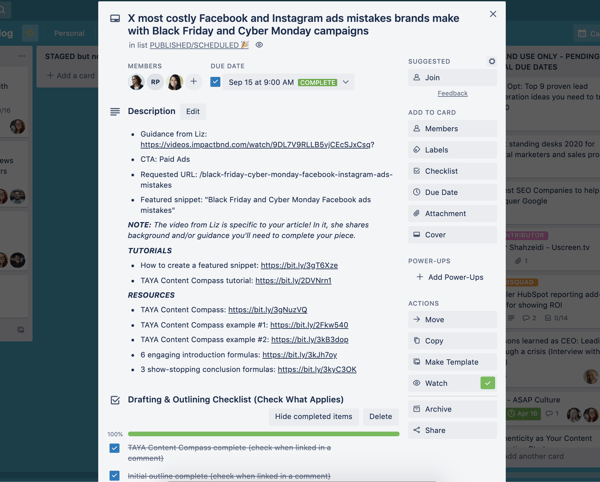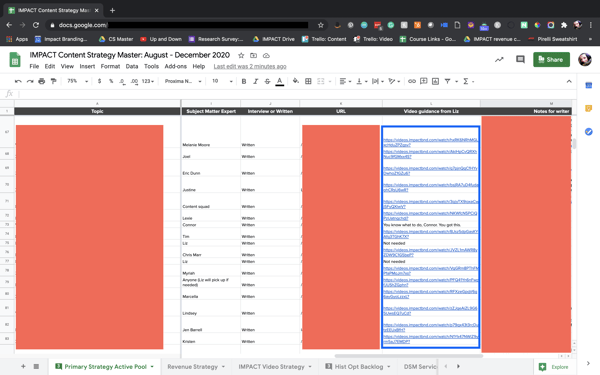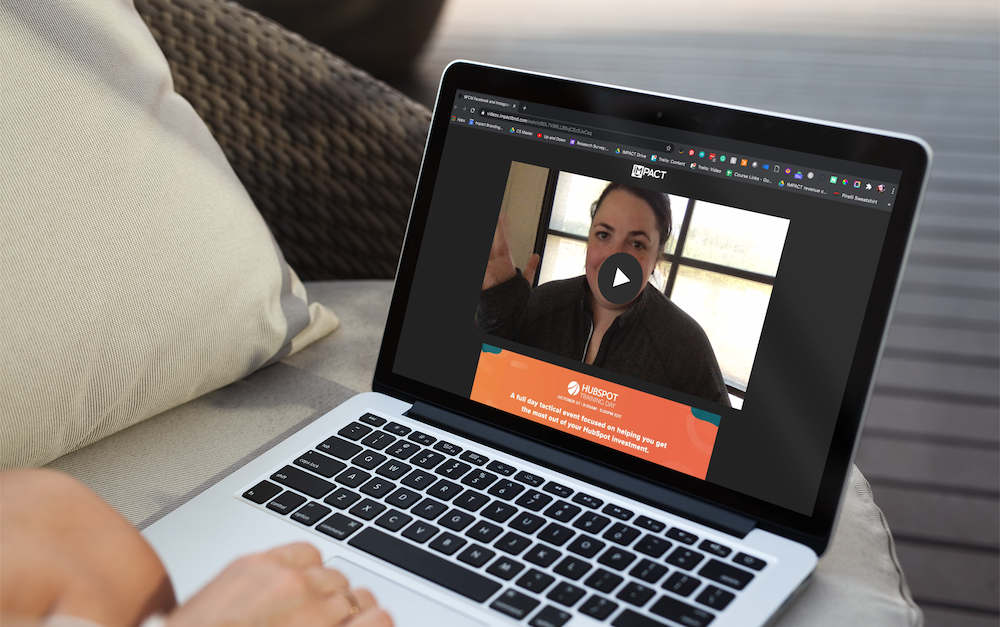One of the biggest challenges content managers and digital marketing managers who oversee a content is getting content creators (freelancers or in-house subject matter experts) to deliver the quality content you want that is in-line with your initial vision.
Seriously, there is nothing more frustrating for you (as the content visionary) and your writer (your content creating “heavy,” if you will) to feel totally aligned going into an assignment — the audience, the scoping, the outline, the keyword strategy, and so on — only to have that initial draft be so far off the mark that you’ll both need to do a lot of work to save it.
So, how do we solve for this?
Well, first, let’s get all of the snoozefest “Duh, we know this already, Liz!” stuff out of the way, so we can get into the juicy goodness I want to share with you today:
You need to be creating the right sales and marketing videos for your audience if you want to lead your industry and hit your goals.
Personalized, one-to-one video is a great way to deliver feedback on content drafts, especially right now when many of us still can’t meet face-to-face.
Using a tool like Trello to run your content strategy is absolutely essential to your long-term success. (Unless you like being stressed out all the time.)
“Liz, you darling, miraculous content machine, what the heck do those three things have to do with getting my content creator(s) to catch the vision of what I want them to create in my content?”
We know video is powerful — not just for audiences, but also for delivering feedback in the content process. And, if you’re a “long-time listener, first-time caller” of my way of viewing the content universe, you know how much I love Trello for governing a content strategy — for both video and written content.
🔎 Related articles:
How to use Trello for your content strategy
How to use Trello for your video strategy
Today, we’re going to bring what you know about video and Trello together in a crazy simple, yet absurdly powerful way that will solve this problem and significantly level-up the quality of your content strategy immediately.
And I’m going to show you how it works by (once again) taking you behind the scenes of how we run the content strategy at IMPACT.
First, a quick refresh on how we use Trello
In addition to custom lanes, labels, and so on, one of the most critical ways we leverage the capabilities of Trello for our content strategy is how we set our team members up for success to complete their content assignments:

Why did I take the time to create a template in Trello with all of these resources already built in? Well, to quote myself:
“If there’s one thing I’ve learned in my years of building processes, your people will not follow the rules if you put your rules and best practices scattered across different places. So, hear me when I say this — centralize as much as possible into your content card template. The more you make people look for things, the less likely they are to stick to best practices or follow the assignment.”
Bottom line, I link every resource anyone could possibly need (how to write an introduction, how to write a conclusion, a link out to our They Ask, You Answer Content Compass, etc.) in a single place, so I remove as many barriers as possible to content creation.
But one of my favorite things that I started adding in a few months ago is this little guy right here:

That innocuous little link is exactly what I’m going to teach you about today, because that’s where the magic happens.
Create a personalized video for every content assignment you give
That’s right. That little guy up there is a link to a personalized, one-to-one video I made for that specific topic. It exists in addition to any guidance I provide on:
Keyword strategy
Call-to-action
Requested URL
Featured snippet instructions
General notes about the topic
What does each guidance video include?
Admittedly, what I include in a guidance video is very much topic-specific. With that in mind, however, here’s an example of one I created for IMPACT video all-star Lindsey Schmidt to help her prep for this article, to show you what I mean:
Please forgive my post-gym “aesthetic.”
Generally speaking, every video will include guidance about:
Who the audience is, why they care about the topic, and any other notes the writer needs to keep in mind. (E.g., “Remember, they don’t know as much about the topic as we do,” or “Don’t forget, this is something that really stresses them out or makes them feel isolated.”)
Ideas for introductions, if any, since I know one of the toughest parts of writing any piece of content is simply getting started. The more I can arm someone with ideas (even if they hate them and go in another direction), the more I can avoid someone sitting down with a frustrating blank slate.
Thoughts on structure, if any, similar to the example above. Sometimes I’m looking for a very specific way of executing a piece of content. That may be a precise architecture of how the content is laid out, or simply the exact “beats” I want an entire piece (or sections within) to hit.
What do you use to record these videos?
Well, as the name of this article clearly states, I use Vidyard’s free Google Chrome extension. It’s the same thing we use for feedback videos on content drafts, because it’s super easy to use. Not only that, you don’t need to upload the video anywhere once you’re done filming. As soon as you’re done filming, a public URL is created that you can copy, paste, and send out into cyberspace.
You can also trim your video, add an animated GIF thumbnail (which includes click-through rates, especially in emails), and more.
How long should each video be?
The example I shared above is on the longer end of my average of 90 seconds to four minutes in length. The vast majority of videos I create I usually around two minutes long.
How often should these videos be recorded?
How often you film these videos is going to depend on how often you roll out new content assignments.
At IMPACT, we roll out content assignments to the company on a monthly basis. So, as part of my process of preparing Ramona (our managing editor) to set up Trello for a new month’s worth of topics, I take about an hour to 90 minutes to record all of my videos in one sitting.
Then, I like those for her in our content strategy master document:

From there, she drops them into each Trello card in the “Guidance from Liz” section:

It’s a bit of a mental marathon to crank all of them out, but it gets more efficient every time I do it. Plus, the results I see from these videos is well worth it.
So, that’s a lot of work — do content writers really find these videos valuable?
Whenever I roll out a new way of helping content creators be more efficient and produce higher quality work, I’m always aware that my little test may backfire. Meaning what I think is a great idea or a superb solution may prove to be a total dud — and that’s OK. It happens to the best of us.
That being said, the first month I did these guidance videos for all content topics, I was dreading the fact that this initiative would be a big ol’ flop. Thankfully, it wasn’t. Not only did we start seeing higher quality first drafts, I got notes like this before I could even ask for feedback:

So, yes. When executed correctly, these videos will not only give you the content you’re looking for the first time around, your writers will also be much happier and feel more empowered to create the content you need.
Remember, these videos will only go as far as your strategy and your vision reaches
Just like investing in HubSpot will not replace your need for a digital marketing strategy, creating videos like this will not put a band-aid over broken content strategies that have a larger dysfunction or fatal flaw within them.
Using personalized, one-to-one video to act as a “coach in your pocket” to your writers only works if:
You’re writing about topics your audience actually cares about.
You’ve gone out of your way to invest in the content management talent you need in-house to do content well.
You, as the content visionary, understand what it takes to plan out a piece of great content, particularly around the needs of your audience.
You understand how different platforms and solutions are required to run a complex content strategy for your company.
You have clearly defined processes and best practices for creating content at your company, so everyone knows what success looks like.
Again, I know the solution I’ve laid out here sounds ridiculously simple. That’s because it is. Sometimes all you need is a simple action to affect broad, sweeping, positive change. But you can only do that if your content foundation is rock solid.
So, before you go rushing off to Vidyard as the savior for all of your content woes, ask yourself how strong your content foundation is. If you’re hitting the right topics, with the right people in the right seats, with the right processes and know-how, trust me when I say these videos are going to rock your world.
If, however, you find your foundation to be a little shaky upon further inspection, don’t panic. You can still implement everything I shared here. Just do so in conjunction with tightening your strategy, streamlining (and documenting!) your processes, and getting the right people in the right seats.
![]()
Read more: impactbnd.com
